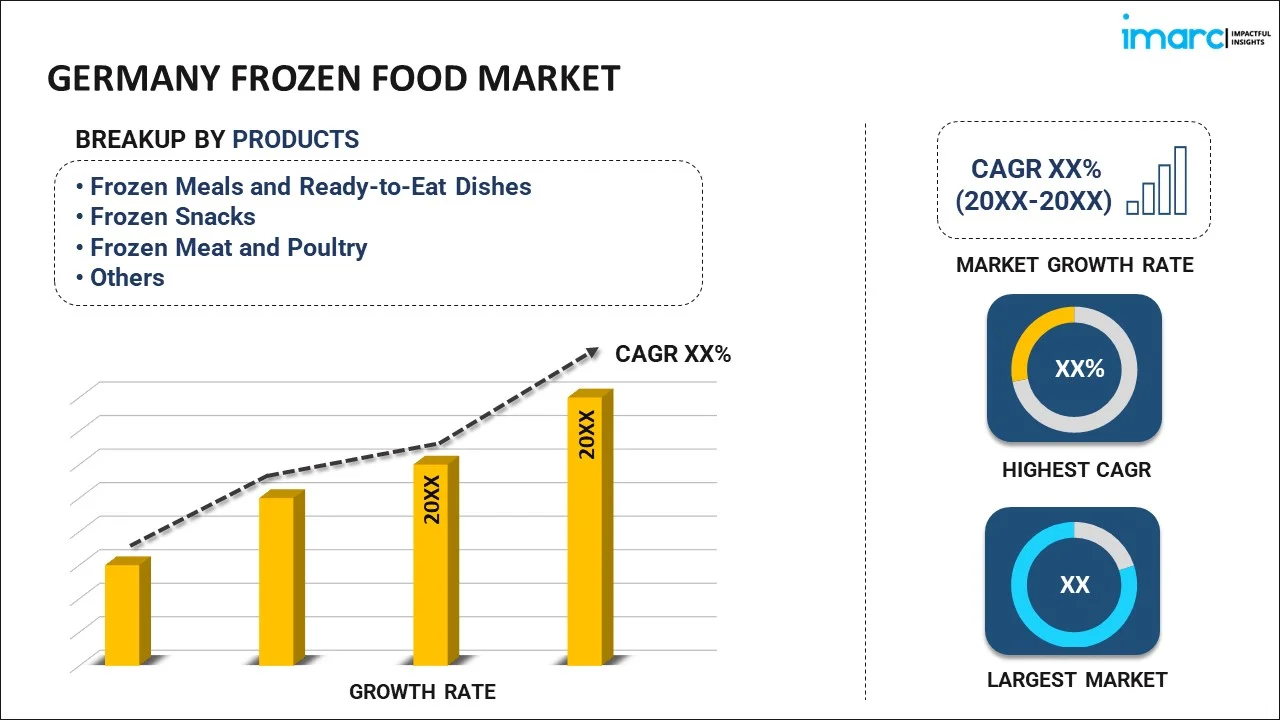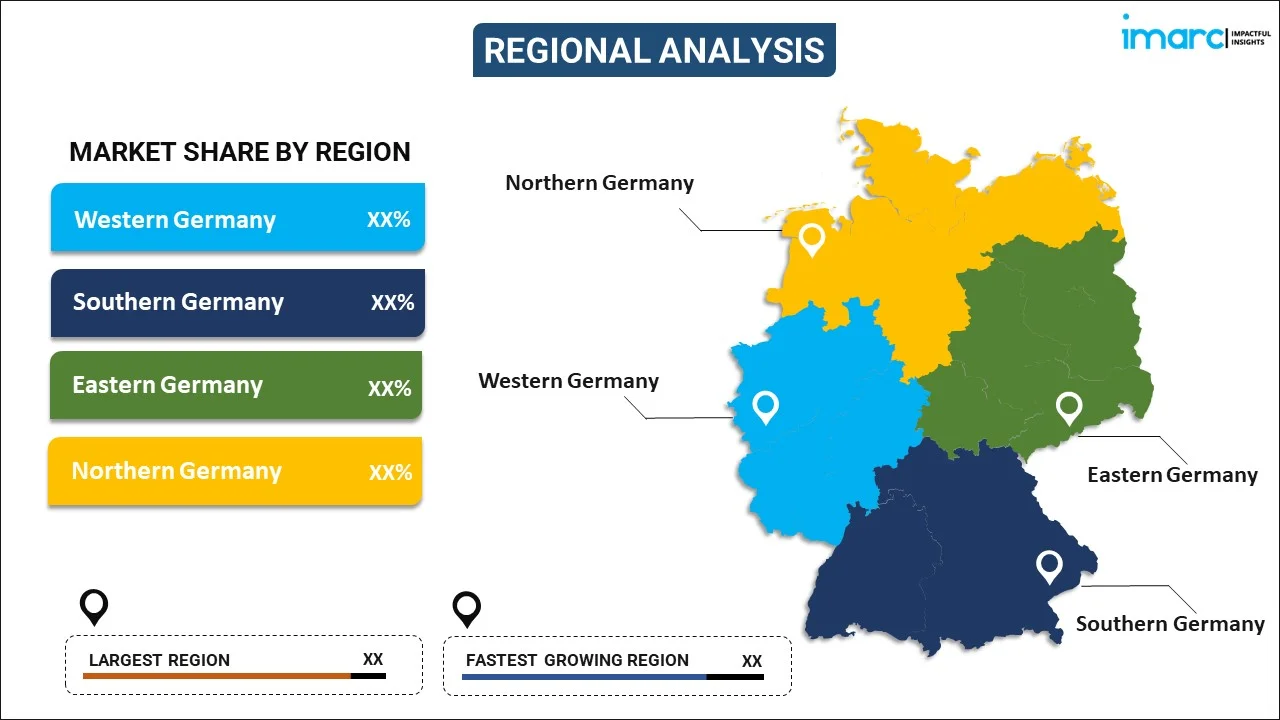
Germany Frozen Food Market Report by Product (Frozen Meals and Ready-to-Eat Dishes, Frozen Snacks, Frozen Meat and Poultry, Frozen Seafood, Frozen Vegetables and Fruits, Frozen Bakery Products, and Others), Distribution Channel (Food Service, Retail), and Region 2025-2033
Germany Frozen Food Market Overview:
The Germany frozen food market size reached USD 11.8 Billion in 2024. Looking forward, IMARC Group expects the market to reach USD 21.6 Billion by 2033, exhibiting a growth rate (CAGR) of 7% during 2025-2033. The Germany frozen food market is driven by an increasing consumer demand for convenience, the rising traction of ready-to-eat (RTE) meals, favorable advancements in freezing technology, a growing preference for longer shelf-life products, and the expanding variety of frozen food options catering to diverse dietary preferences.
|
Report Attribute
|
Key Statistics
|
|---|---|
|
Base Year
|
2024 |
|
Forecast Years
|
2025-2033
|
|
Historical Years
|
2019-2024
|
| Market Size in 2024 | USD 11.8 Billion |
| Market Forecast in 2033 | USD 21.6 Billion |
| Market Growth Rate (2025-2033) | 7% |
Germany Frozen Food Market Trends:
Expanding Production Capabilities Through Advancements and New Units
Advancements in freezing technology enhance product quality by preserving nutritional value, texture, and taste. Innovations like rapid freezing and individually quick-frozen (IQF) methods reduce ice crystal formation, preventing cellular damage in food. These technologies also extend shelf life and improve convenience, catering to the growing consumer demand for high-quality, ready-to-eat meals. As a result, improved freezing techniques are boosting consumer confidence, increasing the popularity of frozen food in Germany, and accelerating imports and exports. For instance, in 2021, Germany ranked 15th for frozen food imports with $340 million and 15th for frozen food exports with $90 million. German frozen vegetable imports had a total value of €598 million, or 20% of the European market, in 2021. Moreover, in the same year, Germany imported 90% of its frozen vegetables from other European countries and 10% from developing countries. Moreover, companies are expanding their manufacturing facilities to cater to the increasing demand for frozen food products in the country. For instance, in April 2023, Nestlé and private equity firm PAI Partners have agreed to establish a joint venture for Nestlé's frozen pizza business in Europe, creating a focused entity in this competitive and dynamic category. Nestlé will hold a non-controlling stake with equal voting rights alongside PAI Partners. The transaction, pending employee consultations and regulatory approval, is expected to close in the second half of 2023. Financial details have not been disclosed.
Demand for RTE Foods by Consumers
The market for frozen food in Germany is extensive and expanding, driven by consumers seeking convenient and high-quality meal solutions. The new generation, increasingly engaged in daily activities, often lacks time for meal preparation, which is fueling the growth of the frozen food sector. According to DTI, per capita consumption rose to 47.7 kg in 2022, while household consumption increased by 4.1 kg, reaching 96.4 kg in 2022. Total sales of frozen food surged by 3.6% to 3.909 million tons in 2022, surpassing the previous record set in 2019 by 2%. These products are preferred for their long shelf life, ease of preparation, and preserved nutritional value, contributing to their growing popularity among consumers.
Germany Frozen Food Market News:
- In February 2023, the Bielefeld-based Dr. August Oetker Foundation donated 500,000 euros to the United Nations Children's Fund UNICEF to support relief efforts for people in the earthquake zones in Turkey and Syria.
- In May 2024, the Cannes Lions International Festival of Creativity announced Unilever as the 2024 Creative Marketer of the Year. The honorary accolade is presented to a marketer that has amassed a body of iconic, Lion-winning work over a sustained period of time, with Unilever establishing a reputation for producing brave, creative, and innovative marketing solutions.
Germany Frozen Food Market Segmentation:
IMARC Group provides an analysis of the key trends in each segment of the market, along with forecasts at the country level for 2025-2033. Our report has categorized the market based on product and distribution channel.
Product Insights:

- Frozen Meals and Ready-to-Eat Dishes
- Frozen Snacks
- Frozen Meat and Poultry
- Frozen Seafood
- Frozen Vegetables and Fruits
- Frozen Bakery Products
- Others
The report has provided a detailed breakup and analysis of the market based on the product. This includes frozen meals and ready-to-eat dishes, frozen snacks, frozen meat and poultry, frozen seafood, frozen vegetables and fruits, frozen bakery products, and others.
Distribution Channel Insights:
- Food Service
- Retail
- Hypermarkets and Supermarkets
- Convenience Stores
- Online
- Others
A detailed breakup and analysis of the market based on the distribution channel have also been provided in the report. This includes food service and retail (hypermarkets and supermarkets, convenience stores, online, and others).
Regional Insights:

- Western Germany
- Southern Germany
- Eastern Germany
- Northern Germany
The report has also provided a comprehensive analysis of all the major regional markets, which include Western Germany, Southern Germany, Eastern Germany, and Northern Germany.
Competitive Landscape:
The market research report has also provided a comprehensive analysis of the competitive landscape. Competitive analysis such as market structure, key player positioning, top winning strategies, competitive dashboard, and company evaluation quadrant has been covered in the report. Also, detailed profiles of all major companies have been provided.
Germany Frozen Food Market Report Coverage:
| Report Features | Details |
|---|---|
| Base Year of the Analysis | 2024 |
| Historical Period | 2019-2024 |
| Forecast Period | 2025-2033 |
| Units | Billion USD |
| Scope of the Report | Exploration of Historical and Forecast Trends, Industry Catalysts and Challenges, Segment-Wise Historical and Predictive Market Assessment:
|
| Products Covered | Frozen Meals and Ready-to-Eat Dishes, Frozen Snacks, Frozen Meat and Poultry, Frozen Seafood, Frozen Vegetables and Fruits, Frozen Bakery Products, Others |
| Distribution Channels Covered |
|
| Regions Covered | Western Germany, Southern Germany, Eastern Germany, Northern Germany |
| Customization Scope | 10% Free Customization |
| Post-Sale Analyst Support | 10-12 Weeks |
| Delivery Format | PDF and Excel through Email (We can also provide the editable version of the report in PPT/Word format on special request) |
Key Questions Answered in This Report:
- How has the Germany frozen food market performed so far and how will it perform in the coming years?
- What has been the impact of COVID-19 on the Germany frozen food market?
- What is the breakup of the Germany frozen food market on the basis of product?
- What is the breakup of the Germany frozen food market on the basis of distribution channel?
- What are the various stages in the value chain of the Germany frozen food market?
- What are the key driving factors and challenges in the Germany frozen food?
- What is the structure of the Germany frozen food market and who are the key players?
- What is the degree of competition in the Germany frozen food market?
Key Benefits for Stakeholders:
- IMARC’s industry report offers a comprehensive quantitative analysis of various market segments, historical and current market trends, market forecasts, and dynamics of the Germany frozen food market from 2019-2033.
- The research report provides the latest information on the market drivers, challenges, and opportunities in the Germany frozen food market.
- Porter's five forces analysis assist stakeholders in assessing the impact of new entrants, competitive rivalry, supplier power, buyer power, and the threat of substitution. It helps stakeholders to analyze the level of competition within the Germany frozen food industry and its attractiveness.
- Competitive landscape allows stakeholders to understand their competitive environment and provides an insight into the current positions of key players in the market.
Need more help?
- Speak to our experienced analysts for insights on the current market scenarios.
- Include additional segments and countries to customize the report as per your requirement.
- Gain an unparalleled competitive advantage in your domain by understanding how to utilize the report and positively impacting your operations and revenue.
- For further assistance, please connect with our analysts.
 Inquire Before Buying
Inquire Before Buying
 Speak to an Analyst
Speak to an Analyst
 Request Brochure
Request Brochure
 Request Customization
Request Customization




.webp)




.webp)












